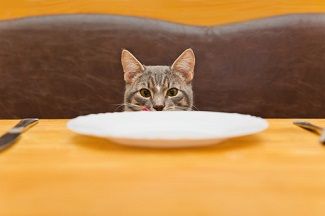AAFP Releases Consensus Statement on Feline Feeding
The recommendations are designed to encourage natural behaviors, reduce stress, and curb overeating in pet cats.
In a recent issue of the Journal of Feline Medicine and Surgery, the American Association of Feline Practitioners (AAFP) released a consensus statement detailing feeding strategies that encourage natural behaviors and thus minimize the risk of “stress-related and/or overeating issues” in pet cats. According to the statement, in contrast with the topic of feline nutrition, relatively little information is available on the feeding process and related quality-of-life issues.

Cats have a strong hunting instinct that causes them to spend about 12 hours a day looking for food. Therefore, they prefer to eat small prey items frequently and in a solitary manner.
Normal feline hunting and foraging behaviors are frequently impaired in the indoor environment, and this has a negative effect on pet welfare, according to the AAFP. Furthermore, pets in multicat households often receive either large meals or an ad libitum food supply, which encourages overeating. With the development of highly palatable, nutritionally dense kibble, pet cats need to expend little effort for a high caloric intake. Finally, competition for food among family cats can lead to stress, territorial behavior, and aggression.
RELATED:
- The Best Advice Veterinarians Can Provide About Nutrition
- AAFP 2018: Decontamination of Toxicoses in Cats
In extreme cases, stress-related feeding behaviors can include gorging, which puts pets at risk for digestive upset and obesity. The AAFP further argued that overweight cats generally become less active than their normal-weight counterparts, further exacerbating weight issues and increasing the risk for associated diseases, such as diabetes mellitus and heart disease.
Key Solutions for Healthy Weight
The AAFP Consensus Statement outlined multiple solutions to help cat owners encourage natural feline feeding behavior and activity. These tools, the AAFP stated, help alleviate “begging for food, feline frustration, and inter-cat conflict,” thus improving the pet-owner relationship and reducing the risk of relinquishment to shelters.
Puzzle feeders can be placed around the home and at different elevations to increase activity and mental enrichment during feeding. Both commercially available and DIY options work well, including placing kibble inside a plastic bottle or an empty cardboard egg carton.
The AAFP also recommended providing multiple small meals per day. Veterinarians should educate owners on the topic of nutrition, including individualized dietary recommendations to maintain optimal body condition in each pet. Treats, although helpful for training cats to use puzzle toys, should comprise 10% or less of a cat’s daily caloric intake. The statement also emphasized the importance of continued monitoring of pet weight and behavior, as well as observing for signs of illness or stress, during dietary changes.
Finally, owners of multiple cats should always provide separate feeding areas for each cat, as well as multiple water bowls and litter boxes. A general rule of thumb is that every cat should be able to eat in an area of the home in which it feels safe.
Dr. Stilwell received her DVM from Auburn University, followed by a MS in fisheries and aquatic sciences and a PhD in veterinary medical sciences from the University of Florida. She provides freelance medical writing and aquatic veterinary consulting services through her business, Seastar Communications and Consulting.
Episode 67: Choosing trusted supplements
October 20th 2021In this episode of The Vet Blast Podcast, Dr Adam Christman chats with Dr Janice Huntingford about the latest insights into selecting the best supplements for your patients, including the importance of recommending and utilizing products that have a substantial amount of science and research behind them. (Sponsored by Vetoquinol)
Listen